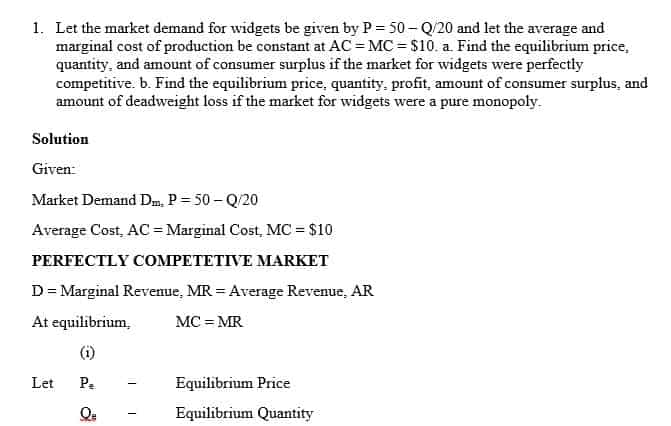Draw the profit maximizing equilibrium for a monopolist with a standard U-shaped average cost curve
Let the market demand for widgets be given by P = 50 – Q/20 and let the average and marginal cost of production be constant at AC = MC = $10. a. Find the equilibrium price, quantity, and amount of consumer surplus if the market for widgets were perfectly competitive. b. Find the equilibrium price, quantity, profit, amount of consumer surplus, and amount of deadweight loss if the market for widgets were a pure monopoly.
Draw the profit maximizing equilibrium for a monopolist with a standard U-shaped average cost curve where the monopolist would be make and economic loss when charging a single price. Would we expect this good to be produced in equilibrium in this case? Now show the profit maximizing quantity assuming that this monopolist can perfectly price discriminate. Is it possible that perfect price discrimination can allow this good to be produced? With reference to your graph, how can you tell if price discrimination allows the monopolist to now make at least a zero profit?
Cournot duopoly. Let the firms be a and b. Let the market demand curve be P = 50 – (qa + qb) and let each firm’s marginal and average cost be 0. Write out the best response equations for each firm and solve for the Nash equilibrium quantities and market price.
The Acme Term Paper Blues contracts with agents who write on-demand papers for college students on various topics. Graph the potential earnings per week for an agent writing 10 page papers for Acme for the following compensation schemes; assume that the workers could write up to 10 papers in a week (meaning your quantity axis should go from 0 to 10). You can either graph all four on one axes or do separate graphs for each scheme. Make sure to label the end points to verify that you have the scheme graphed properly. S1: a = 0, b = $100; b. S2: a = $50, b = $50; c. S3: a = -$100, b = $100; S4: a = $400, b = $0.
Let Sandra’s demand for thingamajigs be P = 10 – q and let Ricky’s demand for thingamajigs be P = 6 – q/2. Let the price equal marginal cost be $4. a. Graph the market demand and efficient quantity assuming thingamajigs are a private good. b. Graph the market demand and efficient quantity assuming thingamajigs are a public good.
Let the market demand curve for electric insect zappers be P = 100 – Q/2 and let the supply be P = 20 + Q/2. Let the market for insect zappers be perfectly competitive. Assume that the insect zappers can sometimes kill some endangered moths, and that due to this negative externality, the production and use of insect zappers creates a $10 per unit marginal external cost. a. Find the equilibrium price and quantity of insect zappers. b. Write out the marginal social cost curve when the external cost is added in to the marginal cost of production curve (the supply curve). Find the efficient quantity of insect zappers and the price that consumers should pay for zappers for the efficient quantity to be an equilibrium.
Answer preview to draw the profit maximizing equilibrium for a monopolist with a standard U-shaped average cost curve



